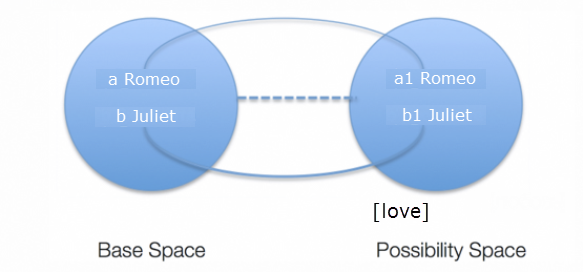MENTAL SPACE
MENTAL SPACE
MENTAL SPACE is the key concept of the Mental Space Theory (MST) and the Blending Theory, introduced into Cognitive Linguistics by Gilles Fauconnier and Mark Turner. Mental spaces (MS) are constantly modified cognitive structures, which are established in real time in discourse and are stored in the short-term memory of the speakers. In the MST the construction of meaning in discourse is viewed as the creation of various configurations of MS.
For example, the statement Romeo is probably in love with Juliet leads to the creation of two MS– the Base Space with the roles of “Romeo”, “Juliet” and a hypothetic MS (the Possibility Space, in which Romeo is in love with Juliet.
While the discourse is created or interpreted, numerous mappings between MS – temporal, spatial, hypothetical, identificational (between a and a1 in th example), counterfactual, cause-effect and others, are established. These links, while uniting MS into flexible configurations, provide free access to all MS (the Access Principle), giving the opportunity to make all the necessary changes in them at any moment.
SIn similarity with the traditional cognitive models, such as frames and scenarios. MS correlate with various domains of the real or unreal world. MS are structured by frames (“love”, for instance), which in discourse are filled with certain roles and characteristics of the objects. For example, in the sentence The president of the United States has blue eyes the role of “the president of the US” is specified by the characteristic “blue eyes”. Despite the fact that MS, like other cognitive structures, are based on our background knowledge, they are not present in our mind in the form of ready-made structures, but are rather constructed in discourse.
Language has a variety of space triggers: adverbial modifiers of time and place, the grammatical forms of the verb, parenthesis, conditional particles, interrogatory constructions and so on. They help to navigate within the configuration of MS, to define the basic space, which initiates other spaces, as well as the focus space which is being built up or rebuilt. These language means are used quite “economically”, since with the help of one expression, one word even, there can emerge multi-dimensional (or multi-directional) links between MS. On the one hand, it ensures the coreference in discourse, and, on the other hand, it enables the optimal segmentation of information so that one and the same element is associated with different cognitive domains.
As a result of the blending of MS there may appear “hybrid” or so called integrated spaces (blends), which, after inheriting the roles and values of the initial spaces, acquire a new structure and new features.
Further reading
Fauconnier G. Mental Spaces: Aspects of meaning construction in natural language. – Сambridge: Cambridge University Press, 1994.
Fauconnier G., Turner M. The Way We Think: Conceptual Blending and the Mind’s Hidden Complexities. – NY: Basic Books, 2002.
Olga Iriskhanova
Translated by Maxim Podvolotsky

